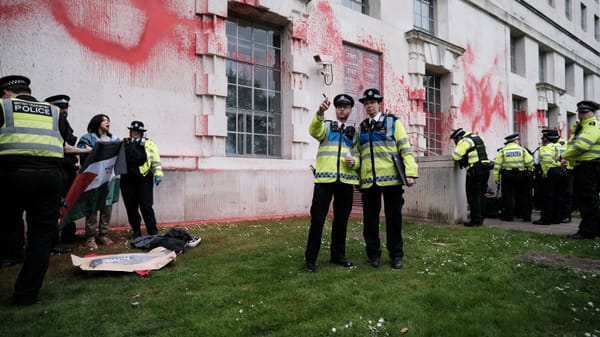Beware the radical ghosts of underground Budapest
Dalia Neis’ new novel takes us inside a mystical world of anarchist diasporism and intersectional comradeship.

In a recent episode of Jewish Currents’ podcast On the Nose, Laynie Soloman from the queer yeshiva SVARA chats to feminist theorist Sophie Lewis about the Genesis 9:7 adage to “be fruitful and multiply”. The pair debate seemingly harsh Talmudic discussions affirming that the failure to reproduce is tantamount to death, but then break down the notion of procreation as attached to the specific act of giving birth to human children. Drawing connections between Torah scholars who assert their communal study as a creative, world-building act on the one hand, and ideas of antipatriarchal, anticapitalist fruitfulness and multiplication on the other, the two imagine a utopian model of “being a parent in the broadest sense”.
Dalia Neis’ new book The Swarm picks up the threads of many of these points. Intertwining a queer, anarchist diasporism – or the combination of Jewish diasporic experience, utopian kinship, and visionary antistatism – with the idea of self-creating one’s family tree, it offers an intersectional comradeship beyond the borders and normative offerings of Jewish life.
In The Swarm, Ashkenazi narrator Dali Muru travels between the fluid geographies of the Carpathian mountains and the ruins of the former Ottoman and Austro-Hungarian empires, ostensibly to make a film. As Dali traverses landscapes of knotty familial roots, imposing mountain ranges and greasy Soviet canteens, they meet a band of radical ghosts – Jewish political anarchists, trans Romani figures and spirits from the mystical Islamic underground – plotting against Viktor Orban’s fascist rule in Hungary. Shifting between scenes set hundreds of years ago and the present, The Swarm’s spirits often meet across the centuries in Budapest’s network of Ottoman baths.
“There are no main protagonists in this film, quite simply because my mind is incapable of chronicling the multitude,” Dali tells the reader. “With the aid of the flock of birds who joined our great army, we became a thin layer of crust that molted on the soft grounds of Budapest.”
This multitude of vampires, water spirits, birds, friends, families and lovers, brought together through Dali’s filmmaking journey, can be seen as an example of what literary scholar Anna Elena Torres defines as “anarchist diasporism”. This term reflects tenets of anarchism such as the rejection of all states, the vision of a world without borders, and an ethical stance of consensus rooted in bodily autonomy. But “diasporism” modifies anarchism to describe “the convergence of Jewish diasporic experience and visionary antistatism” in the work of certain early 20th-century Yiddish poets. Such an approach, Torres argues, bends time and thus imaginatively bends histories of the state in multiple, competing time registers.
This notion of anarchist diasporism extends beyond a specifically Jewish context and the heyday of Yiddish culture to include broader antistatism – encompassing, for example, those practicing self-rule in the mostly Kurdish region of Rojava in northern Syria. It is in such a broader understanding of diaspora anarchism beyond a simply Yiddish-Jewish context that The Swarm finds resonance.
Beyond nation and kin
On the one hand, this resonance is rooted in a rejection of a forced sense of national and ethnic identity bound to trauma, such as when Dali feels discomfort at a Holocaust museum in Jerusalem. As the overhead speaker narrates that the museum rises from “the memory of the holocaust, built on the promised land”, Dali wonders: “But whose promise and to whom?”
Ideas of memory are a major thread running through the book, which often questions such moments of intertwined Jewish trauma and memory and reorients them. In this instance, Dali thinks instead of Chernoe Znamia, an early 20th-century Białystok-based anarcho-communist brigade that struggled to resist nationalism and pogroms, living in the forest and communing with “jackal cries”.
The fact that Dali’s discomfort and disidentification arise from a museum upholding a certain vision of contemporary Jewish life resonates strongly with Berlin-based Neis’ experience in a German context. At the heart of many struggles over Jewish life in Germany is the question of the ties of diasporic Jewish people to a nation state and criticism of Israel. This is bound up in the complexities of the historical and cultural remembrance of the Holocaust in Germany, stretching from the 1980s until today.
This fight centers on how to engage with memories of the Holocaust in the present, especially around questions of how it connects to other instances of extreme violence, namely colonialism. Leftist Jewish activism in Germany today often focuses on critical discussions of diasporic Jewish intersectionality, especially with Palestine solidarity. Neis is part of such efforts through the Jewish Antifascist Bund, which draws its name from the late 19th- and 20th-century secular socialist movement.
The Swarm engages with such issues through its exploration of a type of Jewish comradeship that not only disconnects from a particular nation state, but also from the biological ties of the family tree. “Jewish” becomes linked to the aforementioned idea of diasporic antistatism in Dali’s insistence on antifascist action as intersectional.
Dali builds on this through the idea of mining their specific trauma to explore its resonance with others who have suffered historical violence, asserting: “Holocaust humor opens wallowing self-pity into transformative potential, with seeds of revolutionary empathy for all underdogs across space and time.” The ecstatic visionary experience of communing with ghosts, spirits, animals, plants and elements lies in the excavating of this trauma to undermine the ways in which it has been used to categorise, define and circumvent revolutionary Jewish life for centuries.
No more pining
Such ideas are furthered through contact with a “crushworthy” scholar of the novelist Clarice Lispector. Born Chaya, Lispector fled pogroms in eastern Europe with her family in the early 20th century before settling in Brazil; there, she wrote The Passion According to G.H., in which a woman encounters primordial forces through a mystical experience with a cockroach.
Dali unpacks this experience, noting: “In this desert of seeing, the human body lies within the cosmic body of the whole – the body that is no longer human … we do not speak of origins or chronological cause. It all happened simultaneously, horizontally: chassidic rupture and the antennae of the cockroach in a fevered circular dance.”
Lispector thus becomes a symbol for smashing apart the narrative apparatus. The dissolution of national and ancestral lines slips beyond the cracks of particular historical periods and species into a kind of ancestral goo over which Lispector presides as high priestess.
In this way, Dali learns how to disavow their pre-given family tree: “The reproductive lines, the ancestral lines, the cracks in the bark … no more familial pining, no more nationhood pining, no more homeland pining, no more pining.” Family, nationhood and homeland break down as Dali embraces forms of chosen kinship with spirits, water, earth and wind as well as animals ranging from bats to butterflies to birds.
Akin to Soloman and Lewis’ discussion of broadening a seemingly strict Jewish idea through the power of conversation and interpretation, so does The Swarm creatively imagine a transformative broadening of how Jewish memory, trauma and humor can be reinterpreted into intersectional, diasporic, antifascist Jewish struggles in the present.
It is a difficult task to bridge the gap of political struggles and their enactment in fiction. The Swarm does so in a way that encourages readers to stretch and productively fragment their understanding of what can be seen as Jewish, while maintaining the poetic journey between film, prose and myth.
It is worth taking Dali’s question near the end of the book, posed in a poem called Scenes from a Dunghill, to heart:
“Was I being a pragmatic bitch
Or did I seek something more than
the sum of these parts?”▼
Rachel Pafe is a writer and researcher interested in modern German-Jewish thought and interdisciplinary theories of mourning.




